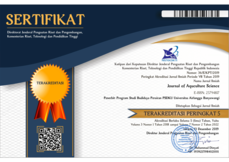Combination of Chitosan Nanoparticles and Cellulose Derivatives in the Preparation of Edible Coatings: Effects on Bacterial Activity and Organoleptic Properties of Tenggiri Fish Pempek

Pempek is a very popular traditional Indonesian food because it has a delicious taste. However, the shelf life of pempek is only about 16 hours at room temperature. This study aims to develop and evaluate edible coatings based on cellulose and chitosan nanoparticles (CSNPs) to extend the shelf life of pempek from Tenggiri fish (Scomberomorus commerson). This study is experimental research divided into two stages. The first stage involves characterizing the edible coating using a Completely Randomized Design (CRD), with tests including antimicrobial activity, water absorption, and viscosity, conducted with 5 treatments and 4 repetitions. The second stage involves applying the coating to pempek and evaluating its shelf life, focusing on TPC and organoleptic qualities using a two-factor CRD with 3×6 treatments and 3 repetitions. The results showed a significant effect (P<0.05) of various formulations on the characteristics of edible coatings. The results showed that the variation of cellulose derivatives and CSNP in the preparation of edible coating significantly affected the coating characteristics (P<0.05). The combined formulation of CMC and CSNP (P5) was selected as the pempek coating, with antibacterial activity of 9.31 mm, water absorption of 1.23%, and solution viscosity of 33.50 cPa.s. In the second stage, the treatment of pempek coating with CMC and CSNP (C2) effectively maintained the quality of pempek until day 3 at room temperature and day 12 at refrigerator temperature.
Copyright (c) 2024 Journal of Aquaculture Science

This work is licensed under a Creative Commons Attribution-NonCommercial-ShareAlike 4.0 International License.



















